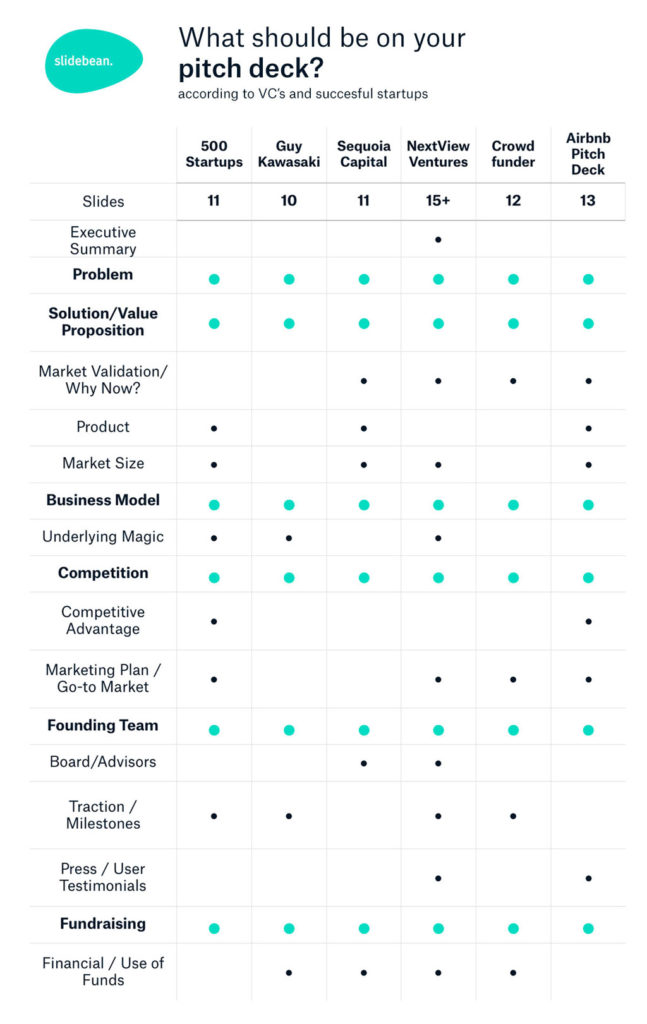The worldwide pandemic situation changed a lot in our lives. Besides lifestyle restrictions, it created a demand for innovative solutions that could help daily routines. In these circumstances, there is a need for rapid prototyping and issuing ready to market products. In most cases, it is impossible without external funding, i.eg. from VC funds. Our previous article shared a few tips about preparing for a meeting with investors. Now it is time to take a closer look at the pitch deck. The general structure of the pitch deck should use 10/20/30 and the AIDA method.
You should also know that there are no universal decks for any situation. You should adjust your file depending on the situation. Something else will be necessary to the general audience, Investors, and corporate representatives. In this article, we will take a look at the most critical aspects of each of them. We hope to help you focus on the most valuable information for each target group. So, let’s begin!
General pitch deck:
– Supports your in-person presentation
The primary purpose of the pitch deck is to support your presentation. A well-designed deck is an excellent background for your speech. That’s why it shouldn’t obscure you. Also, it doesn’t have to contain all the information presented.
– Slides contain only fundamental info, even one word!
The title speaks for itself. Avoid columns of text. Sometimes a simple picture is the best way to strengthen the level of expression.
– Focuses on a problem, unique value proposition, and differentiation from competition
Why is it your startup the best? Tell the audience that you are a problem solver!
– Introduces the market opportunity, team, and plans
Mention all-important business-related topics. It shows that you are aware of them and prepared to be successful.
– Tells your story and vision in simple human terms
Your audience may vary, it can be technicians, CEOs, investors, or corporate representatives. It is wise to not go deep in technical details, so your message should be understandable to all of them.
– For an audience with no prior information about your startup.
It is often the first meeting with your company. Do not expect that the other side researched your solution. Be prepared to describe yourself from the very basic info.
What should be on your pitch deck? According to VC’s and successful startups

credits: slidebean.com
Investor Deck
– Can be read by itself
You should include all the information within your pitch deck. Remember that you’ll send your deck to many investors, and you will not have the power to choose when they read it.
– For an audience with prior information
If the investor spends some time investigating your startup, he certainly did some research first.
– Introduces the problem and covers the key value proposition
Most important topics, according to surveys made within VC’s and successful startups. Describe the problem and show how you would like to solve it. If you are a problem solver, you will gain an interest in many investors.
– Focuses on the market opportunity and advantage of the startup
Another important aspect, according to VC’s and successful startups. Show how you are different from your competitors. And why it is the best time for your startup development.
– Focuses on the team and their relevant qualifications
A better weak project with a great team than a magnificent project with a faint team. It would help if you pointed out why you and your team are best to run the business.
– Discusses go-to-market strategy in detail
Show how you plan to go to the market. Point the most important milestones, and further scaling up your company.
– Talks about your vision in business terms
Here you have got well-specified recipients. Do not be afraid to put business-related vocabulary and shortcuts. MRR, TAM, TRL, and many other startup business acronyms. It can save you some space and show your experience in describing the finances of your startup.
Corporate pitch deck
– Often is the first attempt to meet with the corporate representatives
Your brand is not an essential thing that is being evaluated. Be patient, and introduce yourself.
– Can be read by itself
Same thing as an Investors pitch deck. You will not have the opportunity to present it by yourself. What is more: the same factor is the goal of negotiations: positive cash flow. The only difference is that a corporation should become your client, not a stakeholder.
– Focuses on a problem-solving solution and covers the key value proposition
That’s the most critical part of your presentation. Corporates have many challenges to solve, and their representatives are aware of them. Show your understanding of their problems and that you can solve them.
– Describes team and experience in doing similar projects
Show that you are capable of running the project in the long run. Your team should cover not only the technical aspects of your solution but also further business development. Serious partners will not engage in uncertain cooperation.
– Introduces the current technology readiness level and further steps in developing the product
Do not be afraid to show work that you need to do. But at the same time show what work you finished. Most of the companies will not start cooperating with startups with ideas at TRL 3 or lower. Some of them will not be satisfied with TRL6. The more work you can do on your own, the better.
– Has a well-described business model and shows potential savings
Corporates run many operations every day. If you could improve their processes, make them cheaper, safer, more accurate, and increase your chances of gaining interest in the organization’s decisive people. If you can bring more value than current corporate costs, you will find new clients.
– Introduces other (paying) clients (if they are present)
If your solution is already on the market, don’t hesitate to show your current clients. It not only builds your reliability but indicates that your product is worth paying for. What is more, sometimes it is a special motivation, if the corporate’s direct competitor uses your product!
That was just a summary of the most critical aspects of the pitch decks. If that sounds interesting and you would like to know more, please let us know. We are planning to organize an online workshop regarding designing a pitch deck—all under 200 EUR.
Author: Wojciech Leonowicz
Receive emails that make reading tips & news about business development really productive
We use Mailchimp as our marketing platform. By clicking below to subscribe, you acknowledge that your information will be transferred to Mailchimp for processing. Learn more about Mailchimp's privacy practices here.

